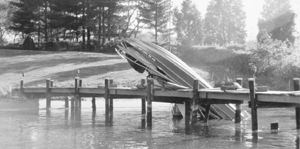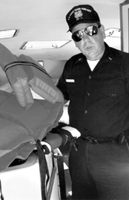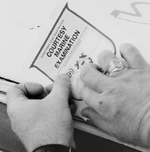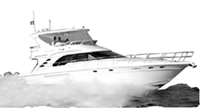 Back to the Water Special
Back to the Water Special10 Tips to Keep The Pleasure In Your Boating
by Sandra Martin
 Back to the Water Special
Back to the Water Special
10 Tips to Keep The Pleasure
In Your Boating
by Sandra Martin
courtesy of Maryland Department of Natural Resources
We've got weeks for this and weeks for that, but to National Safe Boating Week, you may want to pay attention
Water is beautiful and tempting.
On that, Richard McIntire and I agree.
For me, the water is a cradle and its swish and sweep a lullaby. No place do I relax more readily or more fully. No place gives me a better excuse to be out of doors with sun and wind, creamy clouds, skies blue or salted with stars - all in full, living color. My boat gives me reason for being, just as it gives other sailors - like the women in last weekend's 11th Annual Women's Big Boat Regatta, hosted by the West River Sailing Club - reason for doing.
 McIntire sees it different still. "We're
land animals. It's not our natural environment," he said.
McIntire sees it different still. "We're
land animals. It's not our natural environment," he said.
photo by Mark Burns Maryland Cruising Guide editor Capt. Mickey Courtney with Sassy.
The spokesman for Maryland Department of Natural Resources knows all about what can go wrong when boats bring people and water together. From wild weather to rogue wakes to collisions in the dark of night, he's seen many of the ways a pleasure outing goes bad.
"It can go in an instant," he said, recounting a trio of recent incidents, which is what his department calls your outing after it's gone wrong. A sea plane crash, a swamping, an unplanned, after-midnight meeting between tow boat and sail boat: "Three in a row," lamented McIntire, "and the season's not even started."
Whoops. Make that four. In Deale harbor, Safe Boating Week began with a young life lost after six men on a midnight ride in a 12-foot aluminum boat - no life jackets, cushion or ring, no lights, no flares, no bell or whistle - overturned near the point where Rockhold Creek meets Herring Bay. An 18-year-old from Harwood died in eight feet of water, 15 feet from shore.
McIntire's got a point if we want to keep on boating into the 21st century.
So how, I've asked the experts, can we keep our boating a pleasure? From the advice of Natural Resources Police, U.S. Coast Guard and Coast Guard Auxiliary and NBT's consultant Captain Mickey Courtney, we've culled 10 top tips on how to begin a safe boating season.
Before You Go on the Water
1 Have the skills to complete the trip you've planned
If you're not one of the lucky ones who, growing up on the water, learned boating and walking at about the same time, you'd better take to the classroom before you take to the water. The free-wheeling days of learn as you go are over: Maryland law requires a safe boating class of at least eight hours for any boater born after July 1, 1972. Prudent seamanship requires at least that much of everybody.
You get about twice that much classroom time in the Safe Boating and Seamanship classes offered by both the U.S. Coast Guard Auxiliary and the U.S. Power Squadron. A lot is packed into those sessions, from safety to marlinespike seamanship - that's knot-tying to landlubbers - to anchoring to using a compass to reading charts and plotting a course.
One of the first lessons - one clearly not learned before the Rockhold Creek tragedy - is that over-crowded boats sink.
Classes of one sort or the other are almost continually forming, as you'll see by the schedule below.
But when your boat is in danger and your life's on the line, you'll need instant reflexes. Your classroom skills need to have been communicated down the line to your hands before you need them. That takes practice.
Mickey Courtney - a captain qualified on 100-ton vessels who combines 30 years in the Coast Guard Reserve with 15 years in Natural Resources Police and is editor of the chartbook Maryland Cruising Guide - shook his head in dismay as he told the story of the blue-water sailor who said he'd learn navigation when he needed it and rely on his electronics till then. "The time to learn navigation - or anything else - is not when you immediately need it," commented Courtney, wryly.
Good as the survey classes are, they're only introductions. Both Coast Guard Auxiliary and U.S. Power Squadron also teach advanced classes, including navigation. You can also 'charter' a teaching captain to help you bridge the gap from head to hand aboard, on your boat or theirs.
Powerboaters can upgrade their skills with Courtney at Nautical Enterprises (410/867-4152) or with American Powerboat Schools and Charters (410/721-7517).
Sailors can book instructional charters with any of the area's many sailing schools, among them Annapolis Sailing School: 800/638-9192 or 410/267-7205· Chesapeake Sailing School: 410/269-1594 · Womanship: 800/342-9295 or 410/267-6661.
2 Update your life-saving wardrobe
photo by Mark Burns Lifejackets - or PFDs - are part of a Coast Guard
Auxiliary's safety check, made here by Steve Bloss. 
PFDs are lifesavers, but once you hit the water, they'll only save your life if you're attached.
Will statistics make you a believer? Most boating accidents happen when someone falls overboard or a boat capsizes. According to Boat/U.S., nine out of 10 people who drown in boating accidents aren't wearing a life jacket.
How about when the statistics hit close to home? None of the boatload who capsized in Rockhold Creek this week was wearing a life jacket. One died.
"It only works if you wear it," DNR preaches, but there's no law requiring pleasure boaters to wear their personal flotation device. Water skiers and operators and riders of personal watercraft are the exception: they must wear PFDs.
On the other hand, the Coast Guard, who work on the water, requires their crews to wear PFDs at all times, even on dock if they're alone.
The first step to getting close to your PFD is to find one that's comfortable, suiting your body size and your boating plans. The Coast Guard rates PFDs for safety, dividing them into five classes:
Type 1 offshore life jackets will help you stay alive even in rough or remote waters and will keep your face out of water even if you're unconscious.
Type 2 near-shore buoyancy vests will help you stay afloat but will not necessarily turn an unconscious person's face up out of water.
Type 3 flotation aids are popular for water sports and calm, inland waters. You can rely on them to help you stay afloat on your back but not to save you if you're unconscious.
Type 4 are throwable rings and cushions for emergency rescues and buoyancy. Each boat must have at least one on board and readily available. But you don't wear them. You grab them.
Type 5 are special-use devices from fanny packs to suspenders to full vests to deck suits.
Except for type 4, each type works best if you're wearing it. So if your PFD's just any old thing, it's prudent seamanship to start out the season at a marine store, trying on PFDs till you find one you're comfortable in. There are some neat and stylish ones on the shelves, including inflatables in all categories except Type 4.
All are much better than they used to be, when kapok would disintegrate or poly bags spring a leak. "I've inspected some so waterlogged and heavy you might as well put on jugs of water and jump overboard," notes Courtney.
Buy one you can learn to love, so you'll want to keep it close to you - not stowed. Boating law requires that each passenger have a PFD and keep it close at hand and readily available. Prudence requires kids to be vested at all times and everybody to put theirs on if the weather deteriorates.
If you're not going shopping, you still need to try your PFD out and on as each boating season begins. Does the zipper work? Does it still fit? Is it hole-free and in good condition? Will it hold you up when you need it to save your life?
3 Make sure your boat is seaworthy
Service your boat or have it done professionally before you get back on the water. What you want - unless you don't mind trouble on the water - is for your boat to be in top shape from stem to stern. That means inspecting and maintaining the engine, belts, hoses, fluids, through-hull fittings and outdrive gaskets, for a start. "Worn rubber, ruptured hoses or a loose clamp on a holding hose can sink a boat," Courtney cautioned.
If any of this is Greek to you or if you think the list stops there, get a professional to do your inspection and service. Don't skimp on price; be sure your mechanic is reliable; review the work that's been done.
If you need a cautionary story, consider the example of the Chesapeake Country pleasure boater who was sea-testing the boat he'd just had serviced. He was returning to port confidently - just entering the Deale harbor where a life was lost this week - when a fuel line fouled and the engine failed. In an instant - too short and too busy a time for passengers to put on their PFDs - the powerless boat drifted into the stone jetty. Passing boaters saved the craft from breaking up and the passengers from danger, but that boat never returned to the water.
Even if you're confident your boat is in top shape, be prepared for trouble. Stock your repair kit with spare hoses, clasps, fuel and oil filters, oil and belts. As for tools, most marine supply companies sell handy kits with rust-resistant tools to keep on board. They range from fairly basic to fairly inclusive.
4 Get a Coast Guard Safety Check
photo by Mark Burns
A Coast Guard Safety Check won't guarantee your safety, but it will help you take care of yourself. Inspectors, who are volunteers with the Coast Guard Auxiliary, board your boat to walk you through a 27-item checklist to make sure you have proper, serviceable safety equipment aboard.
Despite the ready availability of Coast Guard and DNR brochures full of prudent advice, some of us aren't sure what the basics are. Are you?
Are your navigation lights working? How about your horn? (If it's not, you can buy horn-in-a-can.) Are your flares as out of date as ours were? Are you carrying a daytime safety signal, an orange flag? Is your fire extinguisher expired? Is it attached to the boat where you can reach it if you need it - but not trip on it when you don't? Are your PFDs up to snuff? Is your anchor suitable and secure?
Coast Guard Auxiliary officer Steve Bloss, public affairs officer for Flotilla 15-01, inspected New Bay Times, the boat for this story, and I'm glad to report that when we passed, we got a nice sticker affixed to our port window proclaiming us a safe and inspected craft. If you pass, you will too - along with a boatload of peace of mind.
Before Each Trip
5 Check the weather
On Chesapeake Bay, ignoring the weather is one of the surest ways to get in trouble.
"It can change fast," Courtney advised. "On any shallow body of water, when winds are strong enough, it can rapidly blow up."
In the Bay, waves won't get as high as in the open ocean. Six feet here is pretty significant, and up to seven feet is exceptional. Courtney's worst memory is a "pocket-sized hurricane when waves looked like mountains. They seemed 10-feet high."
But Chesapeake Bay's shorter waves hit harder, as Courtney explains: "When you have six-foot seas in the ocean, the period of the waves is farther apart and the waves stretched out, easier to negotiate. In the Bay's shorter period, you get steep, breaking, bone-jarring slamming about."
The worst day in Courtney's working memory brought waves no higher than six feet.
"It wasn't raining, just a hard blow of 10 to 15 knots out of the south, but it blew up fast and progressed to gale force winds. Boats were pitching and rolling, falling into troughs and rising high, waves splashing on board, even green water on the windshield."
It was enough to create what the Coast Guard calls a "take-a-number Mayday situation."
"One boat after another was calling Mayday, and with our limited resources we could only respond to the most desperate," Courtney recalled. "Some said they were sinking, which wasn't the case, and one doctor demanded instant service saying he had to be on duty even though he was anchored safe. It was chaos all night long."
Even if you've got a good weather report, there's no assurance "you won't get in trouble and have to call for assistance or even more because conditions are not usual and you can't handle them."
Still, if your goal is to make it out and back under your own steam, Courtney advises checking two weather sources before setting out. He checks The Weather Channel for a broader report and correlates what he learns with NOAA weather radio on VHF, which reports a constant reading from data buoys throughout the Bay area.
Under small craft advisories, prudent mariners will think twice before going out, balancing skill and urgency against destination and duration of their journey. In conditions worse than that, said Courtney, "there are cheaper ways to commit suicide."
By the way, the Coast Guard responds to all bonafide conditions of Mayday, distress or urgency - regardless of how you got there. If you're simply out of fuel or wind, however, the Coast Guard will pay attention, but your call will be passed along to a commercial tow company.
6 Check your fuel
Capt. Courtney recommends the one-third rule for powerboaters. That's one-third tank to take you to your destination, one-third to bring your back home, one-third in reserve. "Having run out more than once," Courtney said, "I assure you this is a good rule."
Necessary as fuel is, refueling is one of the danger spots for boaters.
To drive this point home, each Coast Guard boating safety class begins with
a dramatic visual of an explosion at the fuel dock.
Don't provide them a new picture. Each season, reread the chapter on fuel safety in your Coast Guard guide to Boating Safety and Seamanship.
In brief, here's Courtney's advice on safe fueling:
When you're tied up alongside the dock to fuel, passengers should leave the boat. Close all hatches and doors. Wrap the nozzle with absorbent material; in a Clean Marina, they'll make sure you have some. Keep the hose nozzle in contact with metal to avoid sparks. Don't top off: fuel expands in the tank in hot weather and can come out the vent. Use blowers for five minutes before restarting your engine. Meanwhile, open all hatches and air out your boat. Finally, open up your engine compartment and sniff for fumes.
7 Check your power
Courtney said that batteries are too often neglected. Remove the caps and peer in to see that water is covering all the plates. Fill with distilled water. Make sure cables are clean and tight.
Another kind of power can give you trouble, too. If you're using a shore tie, make sure you unplug it before taking off.
8 Load up properly
Develop your own boating checklist and review it each time you go out, modifying what you bring with the kind of trip you're taking. Don't leave shore without safety and first aid supplies, including insurance. Since towing costs mount high and quickly, consider a Boat/U.S. membership, the boater's equivalent of American Automobile Association.
Next, don't overload. Read and believe the capacity plate posted in your boat. Distribute human and load weight evenly so your boat is properly trimmed. Stow whatever you can in lockers, not on deck where objects can fly free or trip you when you're underway. A boat is not a house, as you'll remember as soon as it gets rough.
9 Know where you're starting from
If you're a first-time boater or setting off from an unfamiliar location or new launching ramp, get the lay of the land before you set out on the water.
Locate your position on your chart. What are the aids to navigation? Are there special conditions of geography, current or crowding? Is the channel narrow? Do sandbars lurk? Which way do you turn to reach open water?
By knowing and applying basic rules of color (red on your right returning from seaward) and numbering (the numbers on navigational aids rise as you progress up a tributary) you can usually get your bearings.
On Board
10 Know where you are
Courtney wants everybody who goes out on the water to know where they are and how to get where they're going. "Electronics notwithstanding, know at least basics of piloting and dead reckoning thoroughly enough that you can use it," he said.
Pressed, he allows that there's a difference between local boaters and those whose cruising takes them "far and wide."
Whichever kind you are, you need to know how to read a chart and compass - and have both on board, compass working. To master those skills, you'll have to be a painstaking reader, sign up for a course or brush up on what you once learned.
You'll lay a foundation in either Coast Guard or U.S. Power Squadron introductory courses.
"If you have a chart and read shoal notices and navigational aids, you can do fine in local boating," said Courtney. In such charts as his Maryland Cruising Guide, you'll find magnetic courses to popular areas up and down the Bay.
You need more when you start to range far and wide.
Your compass should be adjusted and any deviation charted on a table. You'll have to apply variation and deviation to get a course to steer.
You'll also have to be able to plot a course with parallel rules or course plotter and use dividers to measure distance. Need help? Sign up for basic and maybe advanced courses in coastal navigation, both offered by the Coast Guard Auxiliary. Or teach yourself with the boater's bible: Charles Chapman's Piloting, Seamanship and Small Boat Handling now edited by Elbert Maloney.
Nonetheless, today's electronics are amazing.
The basics, Courtney said, are your compass - which is "numero uno," and a depth sounder "so you can stay off the bottom and see what the trend is."
The next steps are Loran or GPS.
If you use Loran, that on-board machine takes an Earth-based measure of your latitude and longitude, with calculations based on how long a signal takes to travel between a master and its two slave stations. Where they cross is the location of your boat. But yesterday's height of technology has already been outclassed by the space-based Global Positioning System. Now, said Courtney, "it's up in the air whether Loran will continue beyond the next 10 years."
GPS is satellite based. For as little as $120, you can buy a hand-held system that will track 12 satellites to give you your exact position on our twirling globe.
Still, Courtney would rather trust a human than a machine.
"Electronic aids are just aids, not the epitome you can put full reliance on," said he. "I've had every piece fail, sometimes more than once over the years."
By the way, you want to know where you are so you can find your way home or tell somebody where to come and get you.
You can schedule a personal inspection, arrange a marina-wide inspection day or join one of these already scheduled ones:
To arrange a personal or marina-wide Safety Check, contact District Coordinator of Inspections George Mikulski: 410/757-4931.
Basic Boating Classes
Maryland Department of Natural Resources teaches basic vessel navigation and operation, safety procedures, equipment requirements and weather detection in two-day, three-day or four-day sessions led by Maryland Basic Boating Instructors, members of U.S. Coast Guard Auxiliary and U.S. Power Squadron. Courses this summer meet at a variety of dates and locations:
Other Courses
More Courses?
To find boating safety classes in your area, call the Boat/U.S. Foundation Courseline weekdays 8am-7pm: 800/336-BOAT.
| Issue 21 |
Volume VII Number 21
May 27 - June 2, 1999
New Bay Times
| Homepage |
| Back to Archives |